Nagano’s Natural Air and Water in Every Drop of Vinegar
Sep 12,2024
Nagano’s Natural Air and Water in Every Drop of Vinegar
Sep 12,2024
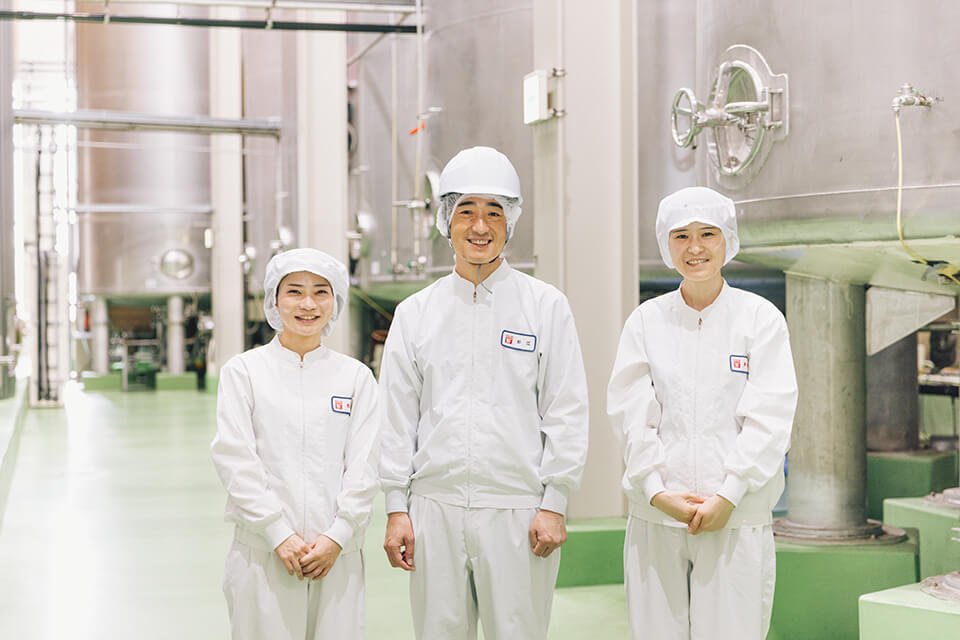

The town of Iijima, Nagano Prefecture, lies in glorious natural surroundings in the valley between the Central and Southern Alps. The air is crisp and the water crystal clear. Despite being in a valley, it’s still 740 meters above sea level. This is the home of Uchibori Vinegar’s Alps Factory — a series of red roofs and white walls that seem to be watched over by the majestic mountains. Uchibori Vinegar, a specialized producer of vinegar founded in 1876, has two production hubs: its main factory in the town of Yaotsu, Kamo district, Gifu Prefecture and the Iijima facility. The shelf in the lobby at the factory’s entrance is lined with all manner of vinegars: rice vinegar, black vinegar, sushi vinegar, and grain vinegar, as well as fruit vinegar, wine vinegar, and balsamic vinegar. Yet what’s on the shelf is but a fraction of the total. Uchibori makes over eight hundred retail products in all, of which some two hundred are produced at this factory. What are the hallmarks of Uchibori’s vinegar and approach to making it? We asked Sugie Takeshi, manager of the Alps Factory, and Matsuda Erika and Sawada Maki of the Business Planning Department.
In Japanese, Uchibori Vinegar is called Uchibori Jozo, literally “Uchibori Brewing.” There’s nothing about vinegar in the name, so people may not realize that that’s what the company makes. Still, it would be no exaggeration to say that virtually everyone in Japan has tasted Uchibori vinegar. Factory manager Sugie Takeshi explains.
“Vinegar is a basic souring agent, and our vinegars are extensively used in various products made by other companies like mayonnaise, Worcestershire sauce, ketchup, dressings, and noodle broth. Besides making our own brand-name products, we also manufacture a wide range of private-label products for supermarkets and other stores.”
Currently about a hundred companies in Japan make vinegar, with the top five accounting for some 70 percent of production. Uchibori Vinegar ranks third. Moreover, there is no other firm of comparable size that makes nothing but vinegar.

Sugie Takeshi, manager of the Alps Factory. After joining Uchibori Vinegar, Takeshi worked at head office in Gifu. He took part in setting up the Alps Factory from the planning stage. He was also involved in building the plant and designing the facilities.
In its early days, the company produced miso and tamari sauce as well as vinegar. It started specializing in making vinegar around 1965. After World War II, synthetic vinegar was common in Japan because things were in short supply. But Uchibori Vinegar has always insisted on fermenting its vinegar.
“The kanji for ‘vinegar’ is written with the sake radical on the right and the character for ‘make’ on the left. And that’s exactly how vinegar is made: through acetic fermentation of sake by acetobacter. Ever since our foundation, we’ve always believed that making a great vinegar starts with brewing sake. When producing rice vinegar, for example, we begin by milling the rice. We then make rice koji and brew the sake. We do it all ourselves. Instead of expanding our lineup with various blended ingredients, we focus on the quality of the vinegar by enhancing the fermentation technology itself. That’s what sets us apart from the competition.”
When making fermented vinegar, some places buy the alcohol they use from elsewhere. Uchibori Vinegar, though, painstakingly makes its own brewing mash or moromi: for example, sake mash for rice vinegar, brown rice sake mash for black vinegar, wine mash for wine vinegar, and cider mash for apple vinegar.
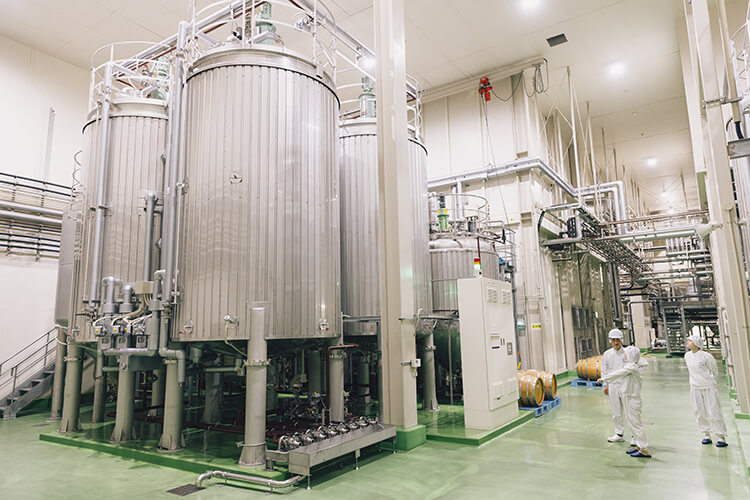
The fermentation room where the moromi or mash is made. Moromi is a semi-solid mass produced through fermentation of the sake ingredients. The clear liquid filtered from it is vinegar.
There’s a traditional method of making vinegar called still fermentation or surface fermentation. Vinegar starter and moromi mash are added to a large vat or tank and left to sit. The mixture then ferments solely through the action of the acetobacter. Acetobacter likes air, and it covers the surface of the liquid, causing it to ferment. Fermentation continues as the heat generated by the process results in convection. The ferment takes two to three months. A further six months or more are required for aging. This is how Uchibori made vinegar in its early days, when it was still a small fermentation plant in Gifu.
“The third head of the company, the current chairman Uchibori Shingo, is now ninety-three years old, and he’s still going strong doing research. All he thinks about every day is vinegar. Back when he was still making vinegar, the taste and quality of vinegar produced by still fermentation were sometimes uneven. He was constantly on tenterhooks, I’ve been told. He wanted to bring customers a more reliable product, so he started exploring how to manufacture a better-quality vinegar. He had an excellent knowledge of new technologies and equipment. Now, at the time, a new technology had emerged on the global fermentation scene called aerated fermentation or complete fermentation, which induces fermentation by introducing air into the liquid. Our chairman immediately seized on this technology and imported the equipment from Germany. ‘This is what we need to install for making vinegar from now on,’ he declared. This move led to a major technological advance. Acetobacter absorbs air and converts alcohol to vinegar. Creating an environment where the acetobacter can efficiently obtain air enables it to multiply steadily, rapidly yielding a pure, high-quality vinegar. That’s how the technology works.”
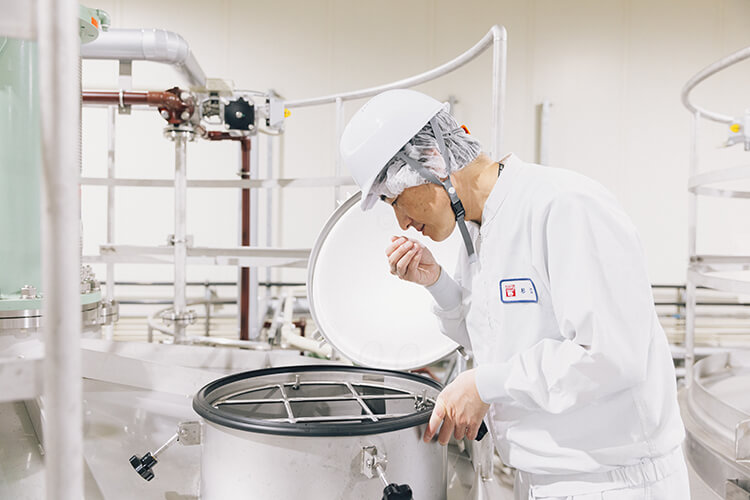
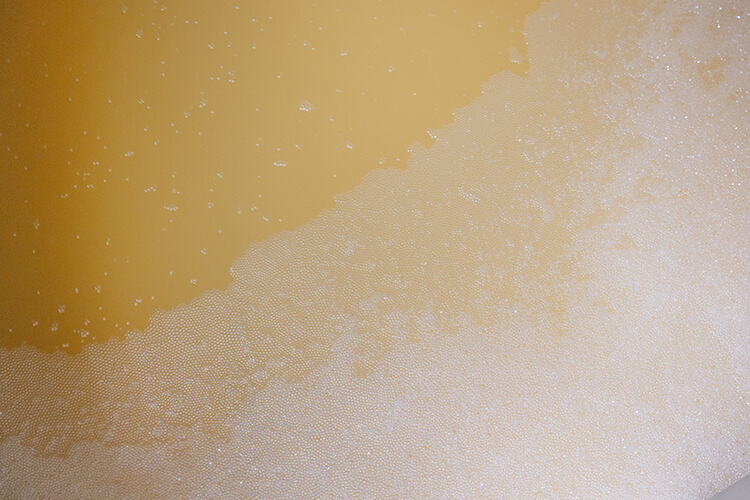
Left: Sugie Takeshi smelling the sake mash to check how it’s fermenting.
Right: Inside the tank.
Yaotsu, the town in Gifu Prefecture where Uchibori Vinegar’s main factory is located, thrived as a water transport hub from the Edo period (1603–1867). It is truly a riverside community. The Hida River passes to the north, and the Kiso River flows through the center of town. When the Alps Factory was established in 2006, the deciding factor in locating it in Iijima was that, like the site of the main factory, Iijima had abundant water.
“When we were going to build the factory here, we drilled test wells before signing the contract. We decided on this site after thoroughly checking the amount and quality of the water supply.”
The soft alpine water pumped from subsurface flows 150 meters underground turned out to be so pure that it could be used as it was to make vinegar. It just needed to be microfiltered. And Uchibori Vinegar didn’t just buy the factory site but also part of the surrounding mountains. It conserved the adjacent forests to ensure a path for the wind flow necessary to making vinegar. After all, the crisp, clean air generated by lush natural surroundings makes a difference to a vinegar’s quality.
“Microorganisms are the stars of the vinegar-making process. Koji fungus. Yeast. Acetobacter. An abundance of water and clean air and an environment conducive to microbial activity are vital. Our job is to ensure the optimal environment for fermentation at all times. We spend our days maintaining that environment by controlling the temperature, managing the production process, and making observations through a microscope. We feel like we’re communing with the microbes.”
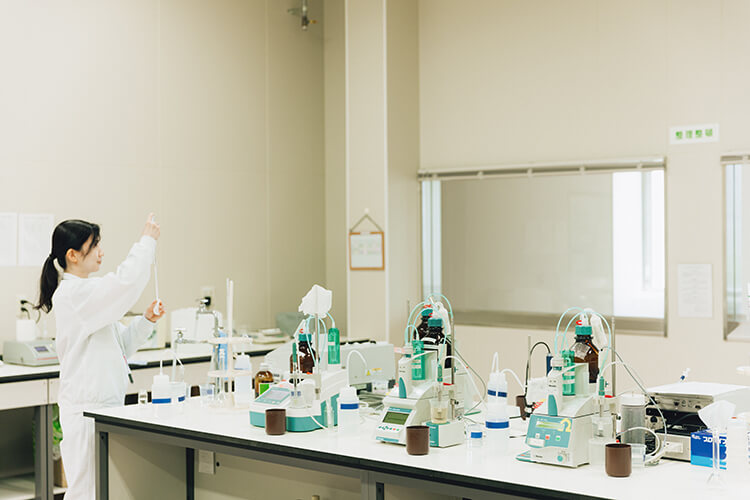
The factory laboratory. Here the ingredients and finished product are constantly monitored for quality.
The Alps Factory has a floor area of 14,245 square meters. The interior is huge, with two stories in some parts. It’s divided into several areas, including a fermentation room, an ingredients storage room, the mash room where the sake is made, and an aging room. It’s quite a walk between them all.
“The factory currently has fifty staff, and every year we all get a medical checkup. Well, our results are pretty good. That may be because we’re consuming vinegar all the time. I guess going back and forth across the factory is good exercise as well [laughs].”
The factory, which has two international certifications for food safety, ISO 22000 and FSSC 22000, is spotlessly clean. There’s not a fleck of dust or dirt anywhere. The staff clean the place themselves every day. A whopping eighteen million liters of vinegar is produced here a year, which explains the rows upon rows of massive tanks in the fermentation area. They’re an impressive sight.
“Freshly made vinegar still has a pungent taste. Properly aging it takes the edge off and results in a more mellow acidity. There are sixty-four aging tanks, each with a capacity of 86,000 liters, plus another fifteen tanks in a separate building and twenty-two elsewhere, for a total of one hundred and one. They say that a manufacturer that attaches this much importance to the aging process is rare indeed.”
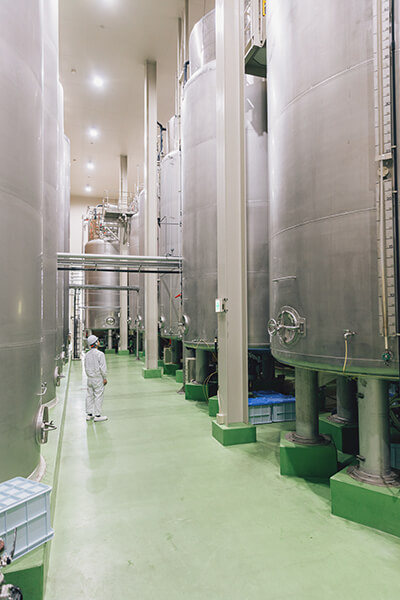
The neat rows of aging tanks almost reach the ceiling two stories above. A veritable forest of tanks.
Interestingly, the factory also has a dashi room, as it’s known. Inside there are rows of huge cooking pots, along with mountains of ingredients for making dashi (stock): Rishiri kelp from Hokkaido and katsuobushi (dried skipjack tuna) produced in Makurazaki, Kagoshima.
“We make dashi every day, starting with cutting the kelp and steaming the katsuobushi and shaving it into flakes. The dashi is blended with vinegar, sugar, and salt to make sushi vinegar, and soy sauce and citrus juice to make ponzu sauce. Making the dashi ourselves rather than using industrial-grade dashi extract results in a better-tasting product.”
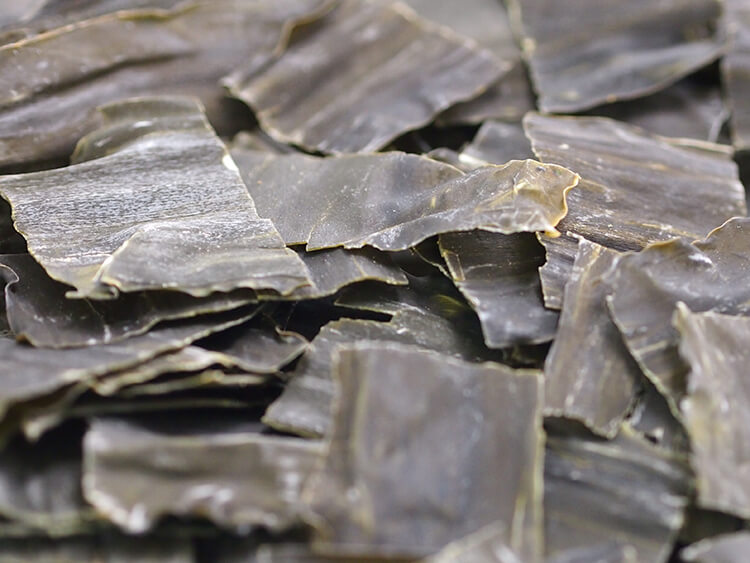

Uchibori makes all its dashi in-house. It doesn’t compromise on the ingredients either. Left: Rishiri kelp from Hokkaido. Right: katsuobushi (dried skipjack tuna) produced in Makurazaki, Kagoshima.
Uchibori Vinegar’s history is peppered with fascinating episodes. Among them is the story of how it made the first wine vinegar in Japan. That was in the chairman’s younger days. Wine vinegar wasn’t then available in Japan, and on finding out that it was the most widely used vinegar in the world, he decided to have a go at making it. After working frantically to perfect it, he wanted to get it evaluated by someone who knew what good wine vinegar tasted like. He accordingly went to see a renowned French chef at the Imperial Hotel in Tokyo. Even though he turned up unannounced, the chef complimented this young vinegar maker from Gifu on his wine vinegar. Even since, Uchibori’s white wine vinegar has been used in the Imperial Hotel’s potato salad.
Moreover, Uchibori Vinegar once triggered a new craze in the vinegar industry by changing the way people think about vinegar. In 2003, it opened the first outlet of a vinegar specialty store called Oaks Heart at the JR Nagoya Takashimaya department store. By suggesting that vinegar could be drunk instead of used as a condiment, it established a whole new category of vinegar, which it dubbed “dessert vinegar.” The man who spearheaded the campaign to proselytize this idea was the bow-tied Uchibori Mitsuyasu, the self-styled “vinegar sommelier,” who was then managing director. Thus began a fad for drinkable vinegars, as readers probably still remember.
“When making the wine vinegar, we bought a machine to crush the grapes and pressed them ourselves. That eagerness to take on new challenges and dedication to the product stem from the days when the present chairman was at the helm. Many of our people have inherited that DNA. They’re strongly committed to improving product quality. Our people often talk to each other about how vinegar made from a particular form of alcohol isn’t yet available on the market. Vinegar is made from alcohol, and it bothers them when there’s an alcohol that hasn’t yet been turned into vinegar [laughs]. Another advantage we have, of course, is that when someone comes up with an idea for making something, we can do it straight away. Even if it doesn’t pan out, it adds to our store of knowledge. It’s important to be adventurous and explore. After all, making vinegar is what we specialize in.”
The ideas for Uchibori’s more than eight hundred products have emerged from its pride in making nothing but vinegar and its thirst for new challenges.
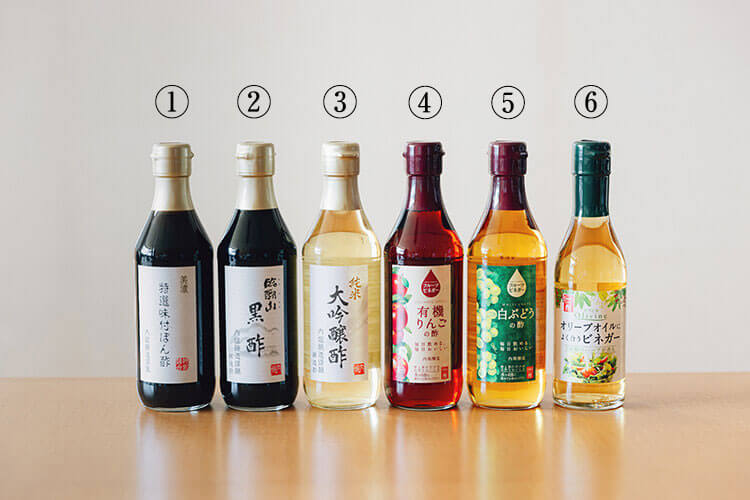
1. Mino Tokusen Seasoned Ponzu
This generated a lot of buzz when showcased on TV by a celebrity. More and more people are getting hooked on it. They swear no other ponzu will do.
2. Rinkosan Black Vinegar
Named after Rinkosan Daisenji, a Buddhist temple in Yaotsu, Gifu Prefecture, where Uchibori’s headquarters are located. It possesses a deep flavor combining mild acidity with umami and sweetness.
3. Junmai Daiginjo Vinegar
The highest grade of vinegar, made from pure rice and rice koji and lovingly aged. The rice is painstakingly milled in a diamond-roller milling machine, of which there are only a handful in Japan.
4. Fruit Vinegar Organic Apple Vinegar
Organic apple vinegar fermented in-house and blended with fruit juice to make it easier to drink. Delicious mixed with alcohol or poured on yogurt.
5. Fruit Vinegar White Grape Vinegar
A grape vinegar fermented in-house and blended with the juice of muscat, Chardonnay, and Sauvignon Blanc to create a floral flavor and aroma. Great mixed with sparkling water or used as a dressing.
6. The Vinegar That Goes Well with Olive Oil
A refreshing grape vinegar infused with five carefully selected herbs. The combination of oil and vinegar makes salads taste better!
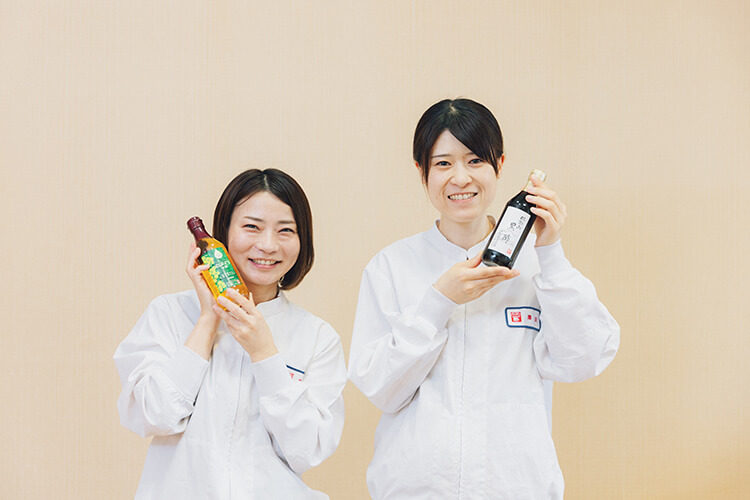
Matsuda Erika (left) and Sawada Maki (right) with their favorite vinegars.
Both work in the Brand Strategy Section of the Business Planning Department preparing promotional materials and handling corporate communications.
Some readers may want to incorporate vinegar in their cooking because it’s healthy but find its sourness off-putting. We therefore asked Matsuda Erika and Sawada Maki of Uchibori’s Business Planning Department for ideas on how to make it part of your daily meals.
“Actually, many people put in too much vinegar when they’re cooking. That makes everything taste so acidic that you’re like, ‘Is this ever sour!’ Using a touch of vinegar as a subtle twist can enhance the flavor of your everyday meals. Put it in soups like minestrone or pot-au-feu, for example, and it sharpens the flavor. Use it in cheese dishes like cheese risotto, and it highlights the cheesy aroma and adds variety and richness. Vinegar also goes well with spices and herbs by bringing out their aroma, so I’d recommend it for herb-grilled dishes and curries as well.”
The secret to enjoying vinegar is to use just enough in your food that it doesn’t taste sour. That way you can keep up the vinegar habit. It might be a good idea to fill a soy sauce pot with some and put it on your dining table.
If you’re looking for something to give a subtle twist to hearty, filling meal or Chinese food, Rinkosan Black Vinegar is just the ticket, according to Maki.
“When you’re making deep-fried fish or chicken, adding a little black vinegar to the sauce gives it a richer, more acidic flavor, so fried foods tastes better. It’s also perfect with stir-fried Chinese dishes like happosai. Rinkosan Black Vinegar has a mellow acidity that brings out the richness of the food. It even makes spicy dishes like mapo tofu taste refreshing. And there are many other varieties of vinegar besides black vinegar, each made with different ingredients and having a different taste. They range from crisp and tangy to mellow and full-bodied. It’s fun to experiment with different varieties depending on what you’re concocting and the taste you prefer. So make vinegar part of your everyday routine. Get started by putting a little on the things you eat all the time, like gyoza, ramen, or salad.”
Vinegar does a lot more than enhance the flavor, adds Erika.
“For example, when you put it in a stew made with bone-in cuts like chicken wings, the meat comes off more easily, making it easier to eat. It also helps the body absorb calcium more efficiently. Also, I always do a lot of meal-prepping, and adding vinegar makes foods last longer, whether it’s a salad, aemono (dressed food), yakibitashi (marinated grilled vegetables or fish), or sappari-ni (refreshing simmered) chicken. Plus vinegar makes boiled or marinated vegetables look more colorful and appetizing.”
What Erika particularly recommends is fruit vinegar.
“Our fruit vinegar, being made from fruit juice, is characterized by its crisp aroma and clean, sour taste. It doesn’t have that pungent vinegary smell. I’d encourage you to drink it blended with still or sparkling water. It also tastes great mixed with milk or soymilk.”
Vinegar assists digestion by stimulating secretion of saliva and gastric juices. With vinegar, you can enjoy healthy, great-tasting meals every day.

SUGIE Takeshi, Manager, Alps Factory
After joining Uchibori Vinegar in 2000, Sugie Takeshi worked on various parts of the production line while learning the equipment. When the Alps Factory was set up in 2006, he was involved in building the plant and designing the facilities as a member of the construction management committee. He has a glass of apple vinegar every evening after his bath.
MATSUDA Erika, Brand Strategy Section, Business Planning Department
Matsuda Erika joined the Brand Strategy Section after stints in product development and sales. There she works on corporate and product branding. She delivers information to a wider audience by designing campaigns on social media and the website. She is also involved in developing the company’s own brand-name products. She is skilled at meal prepping using vinegar.
SAWADA Maki, Brand Strategy Section, Business Planning Department
Sawada Maki joined the Brand Strategy Section after stints in administration and marketing. She is involved in designing product packaging and proofreading the labeling. Like Erika, she also works on running the company’s social media accounts, sharing information about Uchibori Vinegar and its brand-name products. She likes to have a glass of fruit vinegar or black vinegar after a bath. She mixes it with still or sparkling water or milk depending on her mood.
